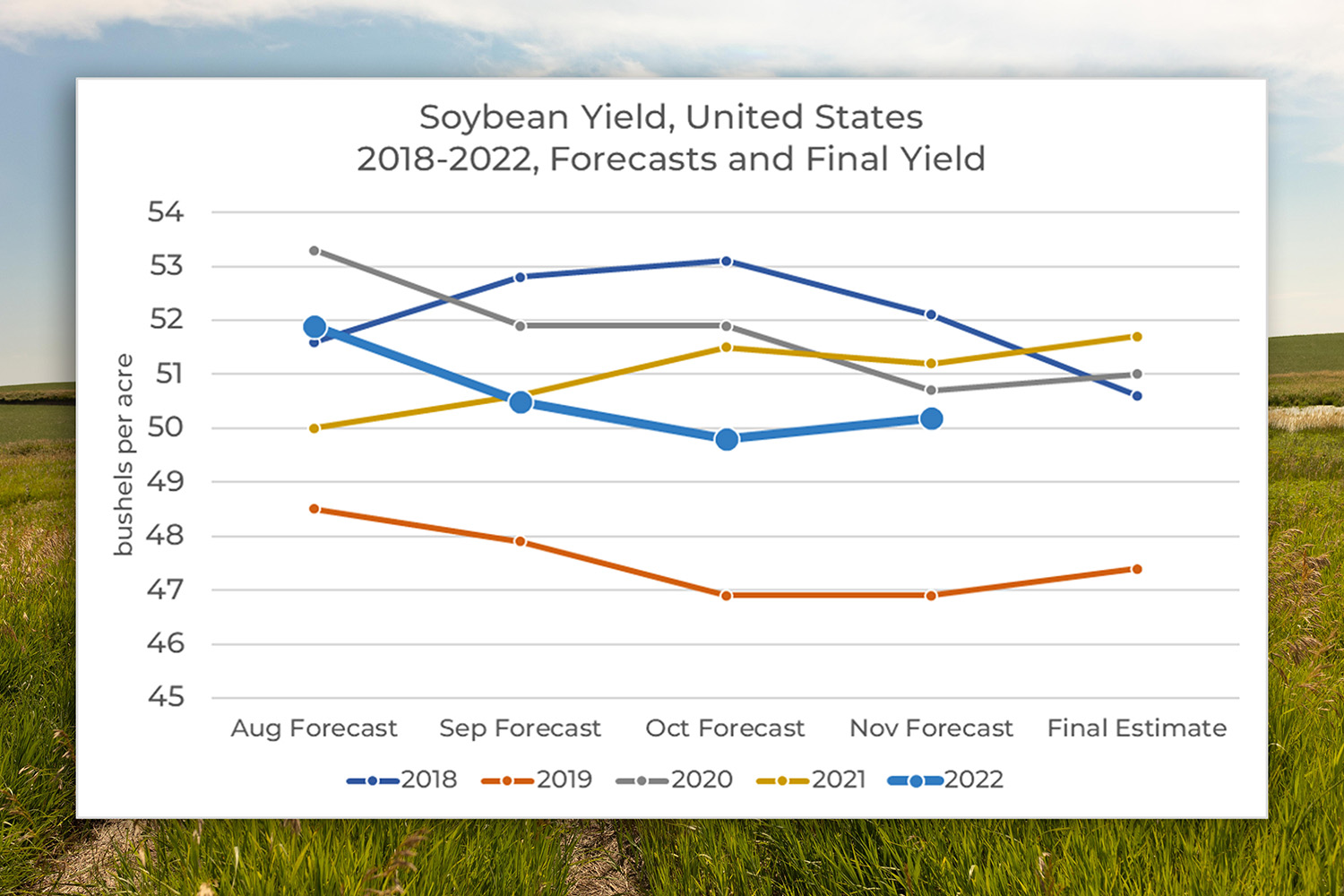
Crop production forecast chart.
Final 2022 forecast for soybean yield and production
November 17, 2022
By Tony Dahlman, USDA-NASS agricultural statistician
*Editor’s note: Tony Dahlman is currently employed as an Agricultural Statistician for the USDA – National Agricultural Statistics Service (USDA-NASS) where he works for the Upper Midwest Regional Field Office in Des Moines. The regional field office is one of 12 in the U.S., covering Iowa, Minnesota, and Wisconsin. Tony has worked for USDA-NASS for 16 years, including a seven-year period in headquarters in Washington, D.C. where his last assignment was the National Soybean Statistician, helping to set all the official soybean estimates for USDA-NASS.
The USDA’s National Agricultural Statistics Service (USDA-NASS) released the November Crop Production report on Nov. 9 forecasting a national soybean yield of 50.2 bushels per acre, up 0.4 bushel from the previous forecast in October, but down 1.5 bushels from 2021. The yield for Iowa producers is forecast at 59 bushels per acre, up 1 bushel from the October forecast, but down 4 bushels from 2021.
Do small crops always get smaller?
A common expression in crop marketing is that “big crops get bigger and small crops get smaller.” In the 22 soybean forecasting cycles between 2000-2021*, there were six years where the national soybean yield was lowered or kept the same from both August to September and September to October. In all six of those years, the yield was again lowered or kept the same from October to November. The 2022 forecasting cycle bucked that trend with the forecast being lowered for the national yield in September and October, but increased from 49.8 bushels per acre in October to 50.2 bushels per acre in November.
*There was no October 2013 Crop Production report due to a government shutdown.
Sources of Data for the November Crop Production Report
The November Crop Production report contains the fourth and final soybean yield and production forecast of the 2022 crop season. Like the previous forecasts in August, September, and October, USDA-NASS uses three major data sources to set yield and production.
The Ag Yield survey generates producer-reported data on their expected yield for their soybean crop in the 2022 crop year. Because more farmers have started or completed the soybean harvest by the November data collection period, it is expected that producers will have a better handle on expected yields. In November, the survey sample size is around 6,100 producers in the United States, including 256 in Iowa.
The Objective Yield survey is the result of NASS-trained enumerators taking measurements in randomly selected soybean fields in the major 11 soybean producing states. The measurements made are dependent on the maturity of the plants in the selected field. Soybean fields that are mature or expected to be harvested in the next three days have soybeans pods collected and sent to the USDA-NASS objective yield laboratory in St. Louis to be counted and weighed. During the November 2022 data collection period, 90% of the samples processed in the lab were mature, compared to only 42% in October. The sample size is 1,530 soybean fields in the United States, including 200 fields in Iowa.
USDA-NASS also uses satellite data which provide indications on crop acreage and yield. Data from farmer reported surveys and enumerator crop measurements are generally given more weight than satellite data in setting estimates.
What is next?
The next updates to soybean acreage, yield, and production estimates will be published in the Crop Production Annual Summary on Jan. 12, 2023. In addition to the Objective Yield and satellite data used in the August through November forecasts, USDA-NASS will also gather data from the December Agricultural Survey. Data collection for this survey takes place during the first three weeks of December and is sent out to over 75,000 producers nationwide, including nearly 3,000 producers in Iowa. This significantly larger sample size and longer data collection period produces higher quality indications to be used for the final estimates.
While these estimates are called “final” they are subject to revision in September 2023 when USDA-NASS has more complete access to stocks and marketing data from the 2022-2023 marketing year. USDA-NASS may also make revisions based on estimates from the Census of Agriculture published every five years.
Back